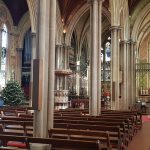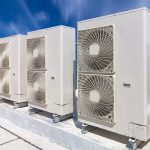Controls for Church Heating
Choosing a controls system for your church heating system can be tricky as there are so many options each with its pros and cons. In this article, we will explain some of the different methods of control and some of the options that we have found work well in churches.
Controls should always be chosen with the main requirements in mind. it can be very easy to look at all the different features with different controllers but sometimes the most basic time clock can be the best-suited option.
What are the requirements for the controls in your church heating system?
Before we can choose a control system for a church we need to know what the requirements are. The following are a few questions that should help you decide what your control system needs to be capable of.
Who is going to be using the controls?
This is important because it determines how easy the controls need to be to not only use but also to access. Some powerful BMS control systems can only be accessed from a laptop and they are password protected. They have thousands of options and can be very overwhelming for someone using them for the first time. Many churches have a very basic time clock with a thermostat as it’s simple to use for anyone and is easily accessible. However, if it is too easily accessible, fiddle fingers may adjust it leading to disagreements on how warm the church should be and some very warm or cold gatherings. (it has been known).
How often is the church used?
If a church is used most days then obviously we need a different control arrangement to a church that is only used once a week on a Sunday.
Does the church need to be able to access the controls remotely?
Some of our church customers have stressed the need to be able to access the heating system remotely from a phone or other device. This could be because many groups use the church and a time program may not be consistent. Having remote access removes the need to go to the church to preheat it when it may not be convenient.
What heat emitters does your church have?
Not all heat emitters are made equal. Different systems may not be compatible with certain control systems. Certain emitters can need specific types of control to work to their maximum efficiency. For example, fan convectors need additional control to regulate their speed or switch from high to low speed. This is obviously not achievable with just a time clock and thermostat. Another example is weather compensation. Some emitters need a constant temperature circuit and so compensation will cause the emitters to work inefficiently. In contrast, systems using emitters like radiators or underfloor heating will work much more efficiently with compensation. Optimization is also very good with radiators and fan convectors but not so good with underfloor heating because of the slow warm-up times. Direct electric heating emitters need no warm-up at all so you need a different type of control again with this. We can provide a free survey of your existing system and recommend what options are available with the system you have. Simply get in touch via our contact page.
How many church heating zones are required?
Some churches have smaller rooms that are used regularly during the week with the main church only used at weekends. It is then clearly inefficient to heat the whole church during the week when just one radiator will do. Bare in mind that in order for a room to be on a separate zone it must be piped separately too. It’s not possible to just add controls without running new pipework to the areas that you want separate from the main zone.
What is the best balance between comfort and efficiency for your church heating?
Comfort and efficiency can unfortunately have an opportunity cost. Control systems do their best to optimize both as much as possible but with ever-increasing energy prices creating the comfort we would like isn’t always affordable. The rate that energy prices have gone up too recently has meant even marginal differences in the way we use our heating, now lead to significant savings over a month.
What are the different types of controls available for church heating and what do they do?
Time and Temperature
These are the two most basic controls that the foundation of most control systems is built on. Time is simply when the heating comes on and when it goes off. Temperature is how warm it heats the room. You can have a simple time clock with a thermostat that will provide you with exactly this. It is one step better than having no control however there is more we can do to really optimize the efficiency and comfort of our heating systems.
Temperature Set Back
A temperature setback is what most houses would have where the temperature is set back to a lower temperature for example overnight when it is not needed. Many church heating systems also use this feature where they have a set back of say 10°C instead of turning the heating off completely when it’s not in use. where a church is used regularly this can be more efficient than having it switched off between uses as the heating is not having to bring it up to temperature from cold. It is also very good for the fabric of the church and musical instruments as fast changes in temperature from hot to cold and back again can do irreversible damage to church organs, grand pianos, and the actual building. However, for many churches, this is more of a luxury than a cost-saving.
Local Control (TRV’s)
Local control, usually comes in the form of thermostatic radiator valves or TRV’s. This enables you to turn down specific radiators without adjusting the whole heating zone or system. This can be very useful if there are areas that get warmer than others or if you don’t want it so warm in a particular area but still want the rest of the heating on full to get it up to temperature. These are most useful for small office or kitchen areas.
Fan Speed Control
If your church has fan convectors or fan assisted radiators there is likely to be different speed settings. This means you will need a controller that is capable of telling the fan convectors at what times they need to be at what speed. This can be set on a time clock and or manually overridden. This prevents the fans blowing at full speed during a service when you want the church to be quiet. However during the warm up before a service then you want them at full speed to get the church up to temperature quickly.
Weather Compensation
Weather compensation is uses the outside air temperature to determine how hot the water should be that’s sent round the system. for example if its -3° outside then the flow temperature would be 80°C. If the outside temperature is 12°C then the controls would tell the boiler the flow temperature only needs to be 50°C.
Optimization
Often confused with compensation optimization is where the control system will optimize the start time of the heating based on the temperature inside the church. for example if its very cold it might come on an 2 hours before the set time. however if its not that cold then it will could come on only 20 minutes before the start time.
Narrow temperature differential
Narrow temperature differential thermostats reduce the temperature swing between demand and satisfaction at the thermostat and hence the variation in room temperature. this should have the effect of marginally reducing the average temperature at which rooms need to be maintained to achieve comfort, assuming that the thermostat is set at the minimum temperature maintained.






